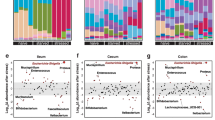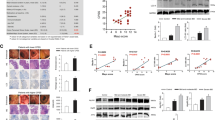Abstract
Background
Nonsteroidal anti-inflammatory drugs (NSAIDs) are popular painkillers, but they have serious side effects, not only in the upper gastrointestinal tract but also in the small intestine. It is well known that psychological stress may exacerbate various gastrointestinal diseases. The aim of this study was to determine whether psychological stress exacerbates NSAID enteropathy and to determine the possible underlying mechanisms for this.
Methods
Experiment 1: mice were exposed to water avoidance stress (WAS) or sham stress for 1 h per day for 8 consecutive days, and then enteropathy was induced by indomethacin. Experiment 2: cecal contents from stress (−) or (+) mice were transplanted into mice that had received antibiotics and in which NSAID enteropathy had been induced without WAS. Experiment 3: mifepristone, a glucocorticoid receptor antagonist, was injected before WAS for 8 days. Small intestinal injury, mRNA expression of TNFα, intestinal permeability, and the microbial community were assessed.
Results
Psychological stress exacerbated NSAID enteropathy and increased intestinal permeability. Psychological stress induced changes in the ileal microbiota that were characterized by increases in the total number of bacteria and the proportion of Gram-negative bacteria. The increased susceptibility to NSAIDs and intestinal permeability due to WAS was transferable via cecal microbiota transplantation. The increased permeability and aggravation of NSAID enteropathy caused by WAS were blocked by the administration of mifepristone.
Conclusions
This study demonstrated a relationship between NSAID enteropathy and psychological stress, and showed the utility of studying the intestinal microbiota in order to elucidate the pathophysiology of NSAID enteropathy. It also showed the impact of stress on the intestinal microbiota and the mucosal barrier in gastrointestinal diseases.






Similar content being viewed by others
Abbreviations
- NSAIDs:
-
Nonsteroidal anti-inflammatory drugs
- HPA-axis:
-
Hypothalamic–pituitary–adrenal axis
- MGB-axis:
-
Microbiota–gut–brain axis
- WAS:
-
Water avoidance stress
- DMSO:
-
Dimethyl sulfoxide
- RT-PCR:
-
Reverse transcription polymerase chain reaction
- FITC-dextran:
-
Fluorescein isothiocyanate dextran
- T-RFLP:
-
Terminal restriction fragment length polymorphism
- PBS:
-
Phosphate-buffered saline
- FMT:
-
Fecal microbiota transplantation
- TLR:
-
Toll-like receptor
- GPB:
-
Gram-positive bacteria
- GNB:
-
Gram-negative bacteria
- NLRP6:
-
NOD-like receptor family pyrin domain containing 6
- CRH:
-
Corticotropin-releasing hormone
References
Turk DC. Clinical effectiveness and cost-effectiveness of treatments for patients with chronic pain. Clin J Pain. 2002;18:355–65.
Gibson GR, Whitacre EB, Ricotti CA. Colitis induced by nonsteroidal anti-inflammatory drugs: report of four cases and review of the literature. Arch Intern Med. 1992;152:625–32.
Matsumoto T, Kudo T, Esaki M, et al. Prevalence of non-steroidal anti-inflammatory drug-induced enteropathy determined by double-balloon endoscopy: a Japanese multicenter study. Scand J Gastroenterol. 2008;43:490–6.
Dorais J, Gregoire G, LeLorier J. Gastrointestinal damage associated with nonsteroidal antiinflammatory drugs. N Engl J Med. 1992;327:1882–3.
Boelsterli UA, Redinbo MR, Saitta KS. Multiple NSAID-induced hits injure the small intestine: underlying mechanisms and novel strategies. Toxicol Sci. 2013;131:654–67.
Syer SD, Blackler RW, Martin R, et al. NSAID enteropathy and bacteria: a complicated relationship. J Gastroenterol. 2015;50:387–93.
Collins SM, Bercik P. The relationship between intestinal microbiota and the central nervous system in normal gastrointestinal function and disease. Gastroenterology. 2009;136:2003–14.
Mayer EA, Knight R, Mazmanian SK, et al. Gut microbes and the brain: paradigm shift in neuroscience. J Neurosci. 2014;34:15490–6.
Aguilera M, Vergara P, Martinez V. Stress and antibiotics alter luminal and wall-adhered microbiota and enhance the local expression of visceral sensory-related systems in mice. Neurogastroenterol Motil. 2013;25:e515–29.
Higashiyama M, Hokari R, Kurihara C, et al. Indomethacin-induced small intestinal injury is ameliorated by cilostazol, a specific PDE-3 inhibitor. Scand J Gastroenterol. 2012;47:993–1002.
Yamada S, Naito Y, Takagi T, et al. Reduced small-intestinal injury induced by indomethacin in interleukin-17A-deficient mice. J Gastroenterol Hepatol. 2011;26:398–404.
Ueda T, Hokari R, Higashiyama M, et al. Beneficial effect of an omega-6 PUFA-rich diet in non-steroidal anti-inflammatory drug-induced mucosal damage in the murine small intestine. World J Gastroenterol. 2015;21:177–86.
Chiu CJ, McArdle AH, Brown R, et al. Intestinal mucosal lesion in low-flow states. I. A morphological, hemodynamic, and metabolic reappraisal. Arch Surg. 1970;101:478–83.
Ishida T, Miki I, Tanahashi T, et al. Effect of 18beta-glycyrrhetinic acid and hydroxypropyl gammacyclodextrin complex on indomethacin-induced small intestinal injury in mice. Eur J Pharmacol. 2013;714:125–31.
Sun Y, Zhang M, Chen CC, et al. Stress-induced corticotropin-releasing hormone-mediated NLRP6 inflammasome inhibition and transmissible enteritis in mice. Gastroenterology. 2013;144:1478–87.
Matsuki T, Watanabe K, Fujimoto J, et al. Quantitative PCR with 16S rRNA-gene-targeted species-specific primers for analysis of human intestinal bifidobacteria. Appl Environ Microbiol. 2004;70:167–73.
Hayashi H, Sakamoto M, Benno Y. Fecal microbial diversity in a strict vegetarian as determined by molecular analysis and cultivation. Microbiol Immunol. 2002;46:819–31.
Sakamoto M, Hayashi H, Benno Y. Terminal restriction fragment length polymorphism analysis for human fecal microbiota and its application for analysis of complex bifidobacterial communities. Microbiol Immunol. 2003;47:133–42.
Guo X, Xia X, Tang R, et al. Development of a real-time PCR method for firmicutes and bacteroidetes in faeces and its application to quantify intestinal population of obese and lean pigs. Lett Appl Microbiol. 2008;47:367–73.
Bacchetti De Gregoris T, Aldred N, Clare AS, et al. Improvement of phylum- and class-specific primers for real-time PCR quantification of bacterial taxa. J Microbiol Methods. 2011;86:351–6.
Gregory JC, Buffa JA, Org E, et al. Transmission of atherosclerosis susceptibility with gut microbial transplantation. J Biol Chem. 2015;290:5647–60.
Wang Z, Klipfell E, Bennett BJ, et al. Gut flora metabolism of phosphatidylcholine promotes cardiovascular disease. Nature. 2011;472:57–63.
Collins SM. Stress and the gastrointestinal tract IV. Modulation of intestinal inflammation by stress: basic mechanisms and clinical relevance. Am J Physiol Gastrointest Liver Physiol. 2001;280:G315–8.
Zheng G, Wu SP, Hu Y, et al. Corticosterone mediates stress-related increased intestinal permeability in a region-specific manner. Neurogastroenterol Motil. 2013;25:e127–39.
Rakoff-Nahoum S, Paglino J, Eslami-Varzaneh F, et al. Recognition of commensal microflora by toll-like receptors is required for intestinal homeostasis. Cell. 2004;118:229–41.
Zoppi S, Madrigal JL, Perez-Nievas BG, et al. Endogenous cannabinoid system regulates intestinal barrier function in vivo through cannabinoid type 1 receptor activation. Am J Physiol Gastrointest Liver Physiol. 2012;302:G565–71.
Muccioli GG, Naslain D, Backhed F, et al. The endocannabinoid system links gut microbiota to adipogenesis. Mol Syst Biol. 2010;6:392.
Shen L. Tight junctions on the move: Molecular mechanisms for epithelial barrier regulation. Ann NY Acad Sci. 2012;1258:9–18.
Zareie M, Johnson-Henry K, Jury J, et al. Probiotics prevent bacterial translocation and improve intestinal barrier function in rats following chronic psychological stress. Gut. 2006;55:1553–60.
Sheehan D, Moran C, Shanahan F. The microbiota in inflammatory bowel disease. J Gastroenterol. 2015;50:495–507.
Goldsmith JR, Sartor RB. The role of diet on intestinal microbiota metabolism: downstream impacts on host immune function and health, and therapeutic implications. J Gastroenterol. 2014;49:785–98.
Lewis K, Lutgendorff F, Phan V, Soderholm JD, et al. Enhanced translocation of bacteria across metabolically stressed epithelia is reduced by butyrate. Inflamm Bowel Dis. 2010;16:1138–48.
Wu Z, Nybom P, Magnusson KE. Distinct effects of vibrio cholerae haemagglutinin/protease on the structure and localization of the tight junction-associated proteins occludin and ZO-1. Cell Microbiol. 2000;2:11–7.
Simovitch M, Sason H, Cohen S, et al. EspM inhibits pedestal formation by enterohaemorrhagic Escherichia coli and enteropathogenic E. coli and disrupts the architecture of a polarized epithelial monolayer. Cell Microbiol. 2010;12:489–505.
Ng KM, Ferreyra JA, Higginbottom SK, et al. Microbiota-liberated host sugars facilitate post-antibiotic expansion of enteric pathogens. Nature. 2013;502:96–9.
Zyrek AA, Cichon C, Helms S, et al. Molecular mechanisms underlying the probiotic effects of Escherichia coli nissle 1917 involve ZO-2 and PKCzeta redistribution resulting in tight junction and epithelial barrier repair. Cell Microbiol. 2007;9:804–16.
Ewaschuk JB, Diaz H, Meddings L, et al. Secreted bioactive factors from Bifidobacterium infantis enhance epithelial cell barrier function. Am J Physiol Gastrointest Liver Physiol. 2008;295:G1025–34.
Karczewski J, Troost FJ, Konings I, et al. Regulation of human epithelial tight junction proteins by Lactobacillus plantarum in vivo and protective effects on the epithelial barrier. Am J Physiol Gastrointest Liver Physiol. 2010;298:G851–9.
Anderson RC, Cookson AL, McNabb WC, et al. Lactobacillus plantarum MB452 enhances the function of the intestinal barrier by increasing the expression levels of genes involved in tight junction formation. BMC Microbiol. 2010;10:316.
Cario E, Gerken G, Podolsky DK. Toll-like receptor 2 enhances ZO-1-associated intestinal epithelial barrier integrity via protein kinase C. Gastroenterology. 2004;127:224–38.
Moussaoui N, Braniste V, Ait-Belgnaoui A, et al. Changes in intestinal glucocorticoid sensitivity in early life shape the risk of epithelial barrier defect in maternal-deprived rats. PLoS One. 2014;9:e88382.
Kelly SP, Chasiotis H. Glucocorticoid and mineralocorticoid receptors regulate paracellular permeability in a primary cultured gill epithelium. J Exp Biol. 2011;214:2308–18.
Hagiwara M, Kataoka K, Arimochi H, et al. Role of unbalanced growth of gram-negative bacteria in ileal ulcer formation in rats treated with a nonsteroidal anti-inflammatory drug. J Med Invest. 2004;51:43–51.
Kent TH, Cardelli RM, Stamler FW. Small intestinal ulcers and intestinal flora in rats given indomethacin. Am J Pathol. 1969;54:237–49.
Dalby AB, Frank DN, St Amand AL, et al. Culture-independent analysis of indomethacin-induced alterations in the rat gastrointestinal microbiota. Appl Environ Microbiol. 2006;72:6707–15.
Watanabe T, Higuchi K, Kobata A, et al. Non-steroidal anti-inflammatory drug-induced small intestinal damage is Toll-like receptor 4 dependent. Gut. 2008;57:181–7.
Xu D, Gao J, Gillilland M 3rd, et al. Rifaximin alters intestinal bacteria and prevents stress-induced gut inflammation and visceral hyperalgesia in rats. Gastroenterology. 2014;146:484–96.
Anand PK, Malireddi RK, Lukens JR, et al. NLRP6 negatively regulates innate immunity and host defence against bacterial pathogens. Nature. 2012;488:389–93.
Acknowledgments
This study was supported by a Health and Labor Sciences research grant into research on intractable diseases, from the Ministry of Health, Labor and Welfare, Japan (http://www.mhlw.go.jp/stf/seisakunitsuite/bunya/hokabunya/kenkyujigyou/).
Author information
Authors and Affiliations
Corresponding author
Ethics declarations
Conflict of interest
The authors declare that they have no conflict of interest.
Rights and permissions
About this article
Cite this article
Yoshikawa, K., Kurihara, C., Furuhashi, H. et al. Psychological stress exacerbates NSAID-induced small bowel injury by inducing changes in intestinal microbiota and permeability via glucocorticoid receptor signaling. J Gastroenterol 52, 61–71 (2017). https://doi.org/10.1007/s00535-016-1205-1
Received:
Accepted:
Published:
Issue Date:
DOI: https://doi.org/10.1007/s00535-016-1205-1




